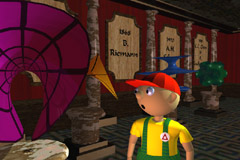Up
Prev
Next
Introduction
Plateau
History
Visualization
Architecture
Crystallography
Weierstraß
Properties 1
Properties 2
Properties 3
Symmetry
Alteration
Periodic
Handles
Production
Scenes 1
Scenes 2
Scenes 3
Results
Exhibition
Numerics
References
Web Links
|
Minimal History Exhibition

|
|
Fig 24. The most important minimal
surfaces of the last centuries are displayed in the minimal surface
exhibition. Video (15.5MB, 4.2MB)
|
Two centuries of mathematical research on minimal
surfaces is accompanied and determined by the discovery of famous example
surfaces. The exhibition of historic minimal surfaces is the first
collection of the most influential examples. The exhibition includes the
classic catenoid of Euler (1745) and helicoid of Meusnier (1770), Scherk's
surface (1835) found as a graph over a square, Enneper's algebraicly given
surface (Fig 24), one of the first solutions of a
boundary value problem by Schwarz, Riemann's surface in terms of the
Weierstraß representation formula, Schoen's triply periodic surfaces in
crystallographic cells, Chen-Gackstatter surface of higher genus
parameterized using the Weierstraß P-function leading to the discovery of
the Costa-Hoffman-Meeks surface, now the most famous piece. Karcher's
modification of the Scherk surface and Hoffman-Karcher-Wei's 'Helicoid
with a Handle' are representatives of the most fruitful period of the last
15 years and symbolize the current high level of the constructive aspects
of minimal surfaces.
|
